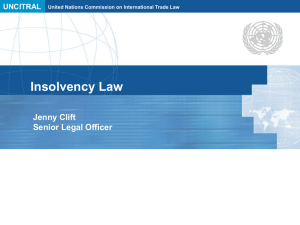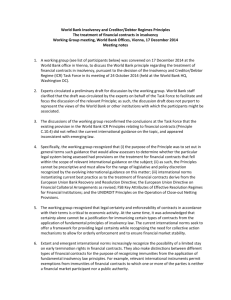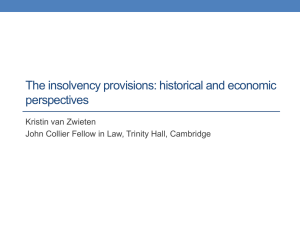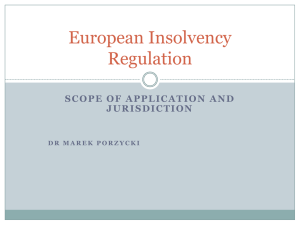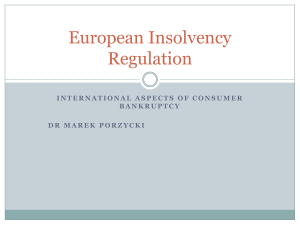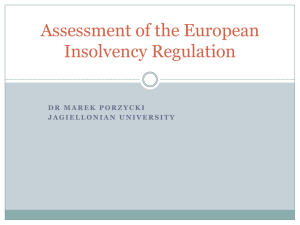II. Questions - The Implementation of the New Insolvency Regulation
advertisement
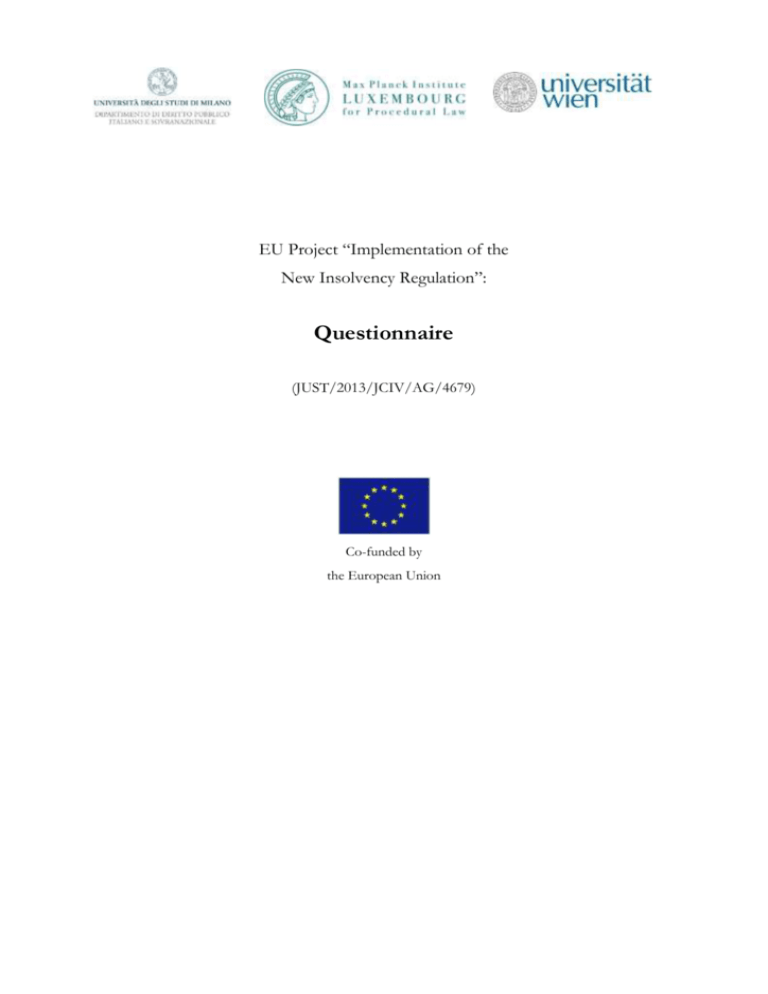
EU Project “Implementation of the New Insolvency Regulation”: Questionnaire (JUST/2013/JCIV/AG/4679) Co-funded by the European Union “Implementation of the New Insolvency Regulation” (JUST/2013/JCIV/AG/4679) INTRODUCTORY REMARKS This paper aims at exploring uncertainties regarding the interpretation and application of the new Insolvency Regulation. Its authors identified three areas which deserve further discussion: the extension of the scope of the EIR, the coordination of main and secondary proceedings and the new group coordination proceedings. In order to initially assess the problems identified, the structure of this paper consists of two parts for each of the areas under scrutiny: In the first part the authors describe the regulatory approach of the new EIR and identify problems. The second part provides for a questionnaire to be answered by the respondents. For your convenience, the questionnaire provides for possible answers, which can be simplycross-checked. However, more elaborate answerswould be more than welcome by the research team. Burkhard Hess Stephania Bariatti Paul Oberhammer 2 Questionnaire EDITORIAL REMARKS Please consider providing the following personal information. Any personal data will only be used to keep you up to date with the further evolution of the project and particularly with the study’s upcoming closing conference in Luxembourg, which is open to the public. Name Profession Email Please note: The questionnaire is accompanied by short summaries of the specific subject. The study is comprised of three core areas: - The Extension of the Scope of the EIR The Interplay between Main and Secondary Proceedings Groups of Companies Should you consider answering the questions within any of these areas, please feel free to submit the questionnaire to: Robert.Arts@mpi.lu Should you have any general remarks, please feel free to submit them here: 3 “Implementation of the New Insolvency Regulation” (JUST/2013/JCIV/AG/4679) § 1 - THE EXTENSION OF THE SCOPE OF THE EIR A. The scope of the EIR-R. I. Reform The EU’s new approach to business failure and insolvency1 has resulted in the extension of the scope of the EIR-R. According to Article 1(1) of the European Insolvency Regulation Recast (herein after EIR-R), the Regulation is applicable to “public collective proceedings” or “interim proceedings” that “are based on laws relating to insolvency […] for the purpose of rescue, adjustment of debt, reorganisation or liquidation”, which include: the debtor’s total or partial divestment of its assets, the appointment of an insolvency practitioner and the supervision of the debtor’s affairs and assets by a court;. or a temporary stay of individual enforcement proceedings in order to allow for negotiations between the debtor and its creditors, provided that these proceedings are not detrimental to the general body of creditors. Accordingly, the EIR-R will not only apply to “classical” insolvency proceedings, but also to collective proceedings: that do not include all of the debtor’s creditors, provided that these proceedings do not affect the claims of creditors which are not involved (Article 2(1) EIR-R) which are based on the mere likelihood of insolvency of the debtor where the court only intervenes on appeal by a creditor or other interested parties (recital 10 EIR-R) that do not entail the partial or total divestment of a debtor or the appointment of an insolvency practitioner and leave the debtor fully or partially in control of its assets and affairs, provided that they are placed – sooner or later – under the control of a court. II. Questions 1. In your view, does the possibility to open insolvency proceedings where the debtor faces non-financial difficulties raise any concerns? (e.g. where “the debtor has lost a contract which is of key importance to him”, as provided for in recital 17 EIR-R) Yes. Please specify. See Communication A new European approach to business failure and insolvency, COM (2012) 742, at 2. In the same vein, in 2014 the Commission adopted a recommendation to “encourage greater coherence between the national insolvency frameworks in order to reduce divergences and inefficiencies which hamper the early restructuring of viable companies in financial difficulties and the possibility of a second chance for honest entrepreneurs, and thereby to lower the cost of restructuring for both debtors and creditors”, COM (2014) 1500. 1 4 Questionnaire No. “Non-financial difficulties [which] give rise to a real and serious threat to the debtor’s actual or future ability to pay its debts as they fall due”, even when due to the loss of “a contract of key importance to [the debtor]”, fall under the general category of pre-insolvency, meant as “likelihood of insolvency”: therefore, proceedings based on such non-financial difficulties should be seen as a subcategory of pre-insolvency proceedings, and should not give rise to specific issues. 2. Is a uniform definition of “insolvency” needed? Yes. It is desirable, in order to avoid that the opening of territorial proceedings prior to the opening of main proceedings could be obtained only in some Member States. Yes. It is important to distinguish among the various proceedings that are covered by the EIR-R. No. The notion of “insolvency” should be determined according to the lex fori concursus principalis oder secudariae. After all, Article 34, second sentence (“where the main insolvency proceedings required that the debtor be insolvent, the debtor’s insolvency shall not be re-examined in the Member State in which secondary insolvency proceedings may be opened”), seems to be aimed at preventing the risks implied by the different national definitions of insolvency. Other. 3. If so, should a liquidity test be preferred, as Recital 17 appears to suggest? Yes. No. Even a balance-sheet test could be suitable. Other. 4. Is the COMI presumption and the new “suspect period” of Article 3(1) EIR-R applicable to pre-insolvency proceedings? Yes. Article 3(1) EIR-R does not make a distinction between proceedings based on insolvency and pre-insolvency proceedings according to the lex fori concursus. No. Presumptions as to the debtor’s COMI should not be applicable to preinsolvency proceedings. In this case, the COMI relocation shall always be covered by the freedom of establishement (Article 49 TFEU)/movement (Article 45 TFEU) . It should be decided on a case-by-case basis. The courts should examine the purpose for the COMI relocation. 5 “Implementation of the New Insolvency Regulation” (JUST/2013/JCIV/AG/4679) Other. 5. Has the EIR-R rendered the CJEU judgment in H2 obsolete, insofar as includes in the scope of the EIR-R proceedings that are based on general company law not designed exclusively for insolvency situations, where these proceedings have been brought in the context of insolvency proceedings? Yes. Please justify. No. Please justify. 6. Do the CJEU Judgments in Schmid3 and H4 – both establishing that the courts of the Member State within the territory of which the insolvency proceedings were opened have jurisdiction to hear and determine an action which derives directly from those proceedings and which is closely connected with them that is brought against a defendant domiciled in a third state – result in an excessive extension of the scope of the EIR-R? Yes. Please justify. No. Please justify. B. The Relationship between Article 1 (1) EIR and Annex A I. Reform Although Article 1 (1) EIR-R provides for a large definition (and description) of the proceedings falling within the scope of the EIR-R, the most important provision is found in the second sentence of this paragraph: “The proceedings covered by the EIR-R are only those listed in Annex A”. Member States should provide the EU Commission with all necessary information. In respect of the procedures listed in Annex A, the Regulation “should apply without any further 2 Judgment in H, C-295/13, ECLI:EU:C:2014:2410. Judgment in Schmid, C-328/12, ECLI:EU:C:2014:6. 4 Judgment in H, C-295/13, ECLI:EU:C:2014:2410. 3 6 Questionnaire examination by the courts of another Member State as to whether the conditions set out in this Regulation are met”. At first sight, Article 1(1) EIR-R incorporates the Radziejewski and Bank Handlowy5 judgment of the CJEU. However, the reference to Annex A give the Member States a freedom to decide whether and to what extent national restructuring proceedings will be covered by the Regulation. II. Questions 7. Does the “Annex-approach” make the new Article 1 EIR-R redundant? Yes. No. Art. 1 can still play a role as a blueprint that should be taken into account when deciding on the proceedings to be included in Annex A. No. Despite the straightforward provisions of the new EIR-R as to the exhaustive nature of Annex A, it should be desirable that the EIR-R encompasses also proceedings not listed in Annex A, where the conditions set out in Article 1 EIR-R are met (with particular reference to proceedings which are going to be introduced in the national legislations, given the length of the new legislative procedure of amendment of the Annexes). Other. 8. If Article 1 should be considered as a substantive provision, what is the role of Annex A? Please specify. C. The Delineation between the EIR-R and the Brussels Ibis Regulation (Recast) I. Reform Two major problems have been identified. First, quite problematic is the delineation between the EIR-R and the Brussels Ibis bis Regulation in case of actions relating to the insolvency. The recast of the EIR-R incorporates in Article 6 the CJEU judgments in Gourdain6 and Seagon:7 actions deriving directly from insolvency proceedings and closely linked with them fall within the scope of the EIR-R. In that respect, recital 16 states that the regulation “should apply to proceedings which are based on laws relating to insolvency. However, proceedings that are based on general Judgment in Bank Handlowy und Adamiak, C-116/11, ECLI:EU:C:2012:739, para. 33 et seq. Judgment in Gourdain, 133/78, ECLI:EU:C:1979:49. 7 Judgment in Seagon, C-339/07, ECLI : EU:C:2009:83, paras. 19 et seq. 5 6 7 “Implementation of the New Insolvency Regulation” (JUST/2013/JCIV/AG/4679) company law not designed exclusively for insolvency situations should not be considered to be based on laws relating to insolvency”. Second, it is questionable whether and to what extent restructuring and pre-insolvency proceedings not mentioned in Annex A of the EIR-R may be subject to the Brussel Ibis Regulation. Recital 7 states that “the interpretation of this Regulation should as much as possible avoid regulatory loopholes between the two instruments. However, the mere fact that a national procedure is not listed in Annex A to this Regulation should not imply that it is covered by Regulation (EU) No 1215/2012”. II. Questions 9. Are there still regulatory loopholes between the EIR-R and the Brussels Ibis Regulation? No. Please justify. Yes. Recital 7 provides that “the interpretation of this Regulation should as much as possible avoid regulatory loopholes between the two instruments”. However, it adds that “the mere fact that a national procedure is not listed in Annex A to this Regulation should not imply that it is covered by Regulation (EU) No 1215/2012”. Accordingly, regulatory gaps are possible. Other. 10. If so, which are these regulatory loopholes and how can they be dealt with? Proceedings that are not listed in Annex A of the EIR-R but fall outside the scope of the Brussels I Regulation (e.g, English schemes of arrangements). These proceedings should be governed by the: Brussels I Regulation; Rome I Regulation; National Law. Other. Please specify. 11. With regard to insolvency-related proceedings, is the so-called “Gourdain formula” (“any action which derives directly from the insolvency proceedings and is closely linked with them”), which has been incorporated in Article 6(1) EIR-R, appropriate 8 Questionnaire for the delineation of between the EIR-R (vis attractiva concursus) and the Brussels Ibis Regulation? Yes. The formula should be interpreted broadly, in light of the relevant case law of the CJEU. Moreover, Recital 35 provides two examples of what a related action is and an example of what a related action is not; these examples are sufficient to shed light on possible borderline cases. No. The formula gives no clear guidance on what is “‘a directly and closely linked action”. Other more recent case law of the CJEU8 has failed to provide a better-suited criterion for the delineation between the EIR-R and Brussels Ibis Regulation. Other. § 2 - THE INTERPLAY BETWEEN MAIN AND SECONDARY PROCEEDINGS A. Instruments to avoid or postpone secondary proceedings I. Reform The recast of the Insolvency Regulation aims to reduce the opening of secondary proceedings which may hamper the efficient administration of the insolvency estate to the detriment of the creditors as a whole. Following practical experience gained from the English proceedings in Collins & Aikmann, MG Rover or Nortel Networks,9 the new regime empowers the court at the request of the main insolvency practitioner to postpone or even refuse the opening of secondary proceedings in specific situations (Articles 36 ff. EIR-R). a) Firstly, the main insolvency practitioner will be entitled to give an undertaking to local creditors which treats them with respect to distribution and priority rights as if secondary proceedings had been opened (so-called synthetic proceedings. Unlike Articles 7, 35 EIR-R, the law governing the distribution and priority rights will be awarded on the basis of a contractualrelated commitment subject to approval by the known local creditors and, if need be, by the creditors or respective procedural bodies of the main proceedings according to national law. In that regard, the instrument of an undertaking, may presumably be understood as an authorization of the main practitioner for deviating from Article 7 EIR-R, i.e. the application of the lex fori concursus universalis. This exemption, however, shall be confined to distribution and priority rights. Therefore, the realization of the debtor’s assets located in the State of his establishment(s) will uniformly be governed by the lex fori concursus. Judgment in Nickel & Goeldner Spedition, C-157/13 , EU:C:2014:2145; Judgment in H, C-295/13, ECLI:EU:C:2014:2410. Collins & Aikman Europe SA [2006] EWHC 1343; MG Rover Belux SA/NV [2007] BCC 446; Nortel Group [2009] EWHC 206 (Ch) = IILR 2010, 47.. 8 9 9 “Implementation of the New Insolvency Regulation” (JUST/2013/JCIV/AG/4679) According to Article 36(1) EIR-R, the scope of undertakings will be confined to the debtor’s assets situated in the Member State(s) in which secondary proceedings could be initiated. At the same time, only (known) local creditors, i.e. creditors whose claims against a debtor arose from or in connection with the operation of a foreign establishment, will explicitly be addressed by an undertaking. Yet, this does not mean that the local estate will be dedicated to local creditors only. Instead, those assets situated in the Member State in which secondary proceedings could be opened (including the proceeds received from their realization) shall form a sub-category of the insolvency estate (cf. recital 43 EIR-R) liable for both local and other creditors, which otherwise would be entitled to lodge their claims in secondary proceedings according to Article 45 EIR-R. However, Article 36 EIR-R raises doubts as to whether or not the distribution and priority rights under the law of the Member State where secondary proceedings could be initiated should apply to all creditors. Applying both universal and territorial insolvency law to the same set of local assets would necessarily entail a conflict of laws, treating local and non-local creditors differently. The approved undertaking produces binding effects on the estate. The insolvency practitioner who is obliged to ensure compliance with the terms of the undertaking shall be liable for any damage caused to local creditors in that respect. b) Secondly, the court seized to initiate secondary proceedings will, at the request of the main practitioner or the debtor in possession and subject to certain conditions, be empowered to stay their opening for a period not exceeding three months. II. Questions In the light of the foregoing, reflections should take place on the following questions: 12. What obstacles, according to your opinion, may synthetic proceedings face a) regarding the giving of an undertaking (e.g. the creditors’ approval); b) regarding the administration of synthetic proceedings? 13. How do you rate the instrument of synthetic proceedings as regards a) its objective to avoid of secondary proceedings; b) its relevance in the context of corporate group insolvencies? 14. Regarding the temporary stay of the opening of secondary proceedings: 10 Questionnaire a) Should the instrument of Article 38(3) subpara. 1 EIR Recast – so as to be more in line with the proposal’s key objective to avoid detrimental secondary proceedings – be extended to situations where the main insolvency practitioner has given or envisages giving an undertaking in the sense of Article 36 EIR Recast, which, however, has not been approved yet? Yes. Please justify. No. Please justify. b) If (a) is answered in the affirmative, should this instrument include the judicial power to close secondary proceedings at the request of the main practitioner once an undertaking, meeting the conditions under Article 38(2) EIR Recast, has been approved according to Article 36 EIR Recast? Yes. Please justify. No. Please justify. B. COOPERATION AND COMMUNICATION BETWEEN COURTS AND/OR INSOLVENCY PRACTITIONERS I. Reform Under the new regulation a new provision instructs the insolvency practitioners to communicate and cooperate among them in order to facilitate the coordination of main and territorial or secondary insolvency proceedings concerning the same debtor (Article 41 EIR-R), as well as in cases of insolvency proceedings relating to two or more members of a group of companies (Article 56 EIR-R). The provisions are quite similar: they are both subject to the requirement that cooperation does not run against the rules applicable to the proceedings; additional caveats are added in the case of insolvency of group of companies. Within the framework of those restrictions cooperation may take any form, including the conclusion of agreements or protocols, and some specific actions are proposed to the IPs. Two additional rules establish the duty to cooperate and communicate regarding the courts involved in proceedings concerning the same debtor (Article 42 EIR-R), or members of the same group of companies (Article 57 EIR-R). Both provisions are subject to the conditions that cooperation does not run against the rules applicable to the proceedings, provide for the same examples of means of cooperation, and are also identical regarding their scope. Again, additional 11 “Implementation of the New Insolvency Regulation” (JUST/2013/JCIV/AG/4679) caveats are added in the case of insolvency of group of companies. An equally new provision introduces the insolvency practitioners’ duty to cooperate and communicate with a court before which a request to open another insolvency proceedings is pending, or which has already opened such proceedings, in order to facilitate the coordination of main, territorial and secondary insolvency proceedings affecting the same debtor (Article 43 EIR-R). A similar provision exists for the case of the insolvency of members of a group of companies, subject to the same restrictions as the rule related to court-court coordination (Article 58 EIR-R). According to recital 48 EIR-R, in their cooperation insolvency practitioners and courts should take into account best practices set out in principles and guidelines adopted by European and international organizations active in the area of insolvency law and in particular those prepared by UNCITRAL. Recital 49 EIR-R adds the possibility of entering into agreements and protocols. II. Questions 15. Have you ever been involved in a cross-border insolvency case where attempts to cooperate (insolvency practitioners -to- insolvency practitioners, court-to-court and court- insolvency practitioners) were made, or are you aware of any attempt of the kind within your jurisdiction? If yes, were they successful (in case of a negative answer please explain why)? Is it realistic to expect the current situation to improve after the Regulation enters into force? 16. In the light of your experience, the main obstacles to cooperation and communication in cross-border insolvency settings are: formalistic procedural law; lack of an express rule authorizing communication/cooperation; lack of an express mandatory rule imposing communication/cooperation; lack of express rules specifying the forms/extent of allowed communication/cooperation; lack of awareness about rules (of whatever nature: for instance, soft law) providing for tools to communicate/cooperate; language difficulties; lack of trust on the counterparty; fear of incurring liability; other. 12 Questionnaire 17. The difficulties regarding communication, cooperation and coordination, described under question nº 2, have been solved by Regulation recast? In other words, is the framework provided for a solid and practical one? Please elaborate on your objections, should you have any. 18. Could you provide for an example matching the caveat provided by the sentence “(…) to the extent that such a cooperation is not incompatible with the rules applicable to the respective proceedings”, which appears in arts. 41, 42 and 43 of the Regulation? 19. In your understanding, the new rules on communication, cooperation and coordination in the regulation recast: impose a duty to communicate/cooperate; impose a duty to try to communicate/cooperate; entail an authorization to undertake it. 20. Are you familiar with some codified best practices concerning the drafting of insolvency protocols? If yes, please specify which: European Communication and Cooperation Guidelines for Cross-Border Insolvency (CoCo Guidelines) (INSOL 2007); EU Cross-Border Insolvency Court-to-Court Principles (University of Leiden and Nottingham Law School 2014); ALI III Global Principles for Cooperation in. International Insolvency Cases (2012); UNCITRAL Model Law on Cross-Border Insolvency (1997) and UNCITRAL Practice Guide on Cross-Border Insolvency Cooperation (2009); IBA Cross-Border Insolvency Concordat (1995). 21. Do you think that such codifications provide sufficient guidance? If no, please specify in what respect they are insufficient. 13 “Implementation of the New Insolvency Regulation” (JUST/2013/JCIV/AG/4679) C. Agreements and protocols I. Reform Among the possible instruments for enhancing cooperation and communication between insolvency practitioners, the EIR now explicitly mentions cross-border insolvency protocols or agreements – hereinafter: protocols (Articles 41(1) and 56(1) EIR-R). They will indeed retain their practical importance whenever no recourse is made to new alternatives such as synthetic proceedings (Article 36 EIR-R) and coordination plans (Article 72(1)(b) EIR-R), which are not likely to be adopted in all secondary proceedings, and, respectively, corporate group insolvencies. However, the EIR does not provide any complete set of provisions governing protocols, while national rules addressing the topic, assuming such rules exist, can be incompatible with each other. This amounts to an increased level of legal risk regarding the implications of protocols (including the insolvency practitioner’s liability), which in turn could make them less appealing. However, determining the proper interpretation of the applicable provisions might reduce uncertainty. II. Questions 22. Which are, in the light of your experience, the main obstacles to the conclusion of protocols? Lack of clear-cut rules concerning applicable law; Uncertain legal basis; Uncertain legal nature; Inadequate or uncertain liability regime; Legal uncertainties concerning the power to approve a protocol; Conflicting legal obligations applicable to courts or insolvency practitioners; Lack of incentives; Other (please specify). 23. Are there, in your experience, jurisdictions that provide satisfying answers to such concerns? 24. According to your experience, which issues are commonly addressed in insolvency protocols or agreements? Determination of the insolvency estate; 14 Questionnaire Assets covered by the parallel proceedings; Allocation and distribution of assets; Powers of the insolvency administrators; Claims process and distribution; Litigation issues; Discovery and information sharing; Avoidance actions; Disposition of statutory insolvency rules; Resolution of disputes arising out of the protocol; Other (please specify). 25. Which are, in your opinion, the issues that protocols should deal with after the entry into force of the revised European Insolvency Regulation, considering that the Regulation addresses many problems that are normally tackled by insolvency protocols or agreements? 26. Which is, in your opinion, the legal nature of insolvency protocols in your jurisdiction? Gentlemen’s agreement; Contractual arrangement; Procedural tool; Other (please specify). 27. Should you take the view that the protocol is a contractual arrangement, which law should be applicable? 28. Please specify whether in your jurisdiction: a) there are rules, principles or guidelines concerning the conclusion of protocols in cross-border insolvencies. 15 “Implementation of the New Insolvency Regulation” (JUST/2013/JCIV/AG/4679) b) insolvency practitioners or courts are entitled to conclude insolvency protocols or agreements. If so, under which conditions or circumstances? (Please distinguish between insolvency practitioners and courts). c) courts are empowered to approve or authorize insolvency protocols or agreements concluded by insolvency practitioners. If so, please specify: (i) which are the legal effects of the court approval or authorization; (ii) under which circumstances a court may refuse approval or authorization. d) protocols have binding effects upon: (i) the insolvency practitioner; (ii) the insolvency estate’s creditors; (iii) the relevant courts; (iv) others. e) an insolvency administrator can be held liable for breach of the terms of an insolvency protocol or agreement. 29. Do you think that protocols may establish coordination mechanisms that go beyond the provisions of the revised European Insolvency Regulation, in particular by setting stricter cooperation duties for insolvency practitioners than those applicable to group coordination plans and recommendations If so, please specify any provisions of the revised European Insolvency Regulation that may restrict private autonomy. 30. Do you believe that coordination of cross-border bank insolvency proceedings under the Bank Recovery and Resolution Directive (Directive 2014/59/EU) can serve as a model for the coordination of proceedings falling within the scope of the revised European Insolvency Regulation? If no, please justify your answer. If yes, do you believe that protocols could provide for: Enhanced obligations to exchange information; Common drafting of coordination plans; Common policies on public communication; The establishment of resolution colleges comprising insolvency practitioners; Reciprocal commitments to consider the interests of creditors participating in other proceedings, even in cases where no synthetic secondary insolvency proceedings are opened. 16 Questionnaire § 3 - GROUPS OF COMPANIES The EU legislator considers the EIR’s lack of specific rules dealing with groups of companies as an obstacle to the efficient administration of the insolvency of members of a multinational group and to the successful restructuring of the group as a whole. The reform is based on a “procedural coordination” approach which respects each group member’s separate legal identity (cf. Recital 54). Consequently, “substantive consolidation” was not considered a viable option. The following section will focus on key reform issues having an impact on the insolvency of groups of companies: the clarifications of the COMI concept (I.), the coordination between insolvency proceedings relating to group members (II.), and the provisions specifically introducing so called “group coordination proceedings” (III.) A. The COMI Concept and Groups of Companies I. Reform a) The definition of group of companies in Article 2 EIR-R. Article 2 nos 13 and 14 EIR-R provide for a definition of group of companies which was inserted during the tripartite negotiations. According to no. 13 “group of company” means a parent undertaking and all its subsidiary undertakings. This definition avoids any reference to the concept of a moral person. What counts is the “control” of the parent company over the subsidiary. Usually, the group of companies addressed by the EIR-R consists of at least two moral persons having their COMI in different Member States (cf. Article 56 EIR-R). However, the delineation between a “subsidiary undertaking” (Article 2 no 13) and an “establishment” (Article 2 no 10) is equally not entirely clear as the latter might be a (controlled) moral person (and, as such, a “subsidiary undertaking”). In its judgement Burgo Group10, the CJEU held that secondary proceedings can be opened when the establishment has a distinct legal personality. Consequently, the EIR-R provides for two alternatives. According to the first one, the court of the parent company opens insolvency proceedings for the whole group (and secondary proceedings may be instituted in the member states where the subsidiary operates); under Articles 19 and 20 EIR-R the decision on the opening of the proceedings is automatically recognised in all other Member States. In the second option, separate insolvency proceedings may be opened for each individual group member at its respective COMI and these proceedings may be coordinated by Articles 56 ff. and 61 ff. EIR-R. b) The COMI. The reform aims to refine the COMI concept by including a definition in Article 3 EIR-R which, in essence, corresponds to today’s Recital 13. According to Article 3(1) EIR-R, the debtor’s centre of main interest “shall be the place where the debtor conducts the administration of its interests on a regular basis and which is ascertainable by third parties.” In addition, the new provision curtails the presumption enshrined in Article 3(1) subpara. 2 according to which the debtor’s COMI is located at the place of the company’s registered office. That presumption shall only apply if the registered office has not been moved to another Member State within the three10 Judgment in Burgo Group, C-327/13, EU:C:2014:2158. 17 “Implementation of the New Insolvency Regulation” (JUST/2013/JCIV/AG/4679) month period prior to the request for the opening of insolvency proceedings. It is the purpose of this provision to prevent “fraudulent or abusive forum shopping”. If the presumption under Article 3(1) EIR-R applies it should, according to Recital 30, be possible to rebut it “where the company’s central administration is located in a Member State other than that of its registered office, and where a comprehensive assessment of all the relevant factors establishes, in a manner that is ascertainable by third parties, that the company’s actual centre of management and supervision and of the management of its interests is located in that other Member State.” c) COMI location. The European legislator refrained from creating a real “group COMI”. It did, however, incorporate major elements of the ECJ’s finding in Interedil11 in the EIR-R (see Recitals 28 and 30). The reform, thereby, provides a sufficient basis for a flexible approach taking into account group COMI considerations in order to improve the coordination of insolvencies related to different members of a corporate group. The new Recital 30 highlights the significance of the company’s “central administration and supervision” and of the “management of its interests”. It, therefore, albeit cautiously, opens the door for a more “head office” or “mind of management” oriented approach, which, in turn, renders it possible to locate the COMI of a subsidiary company at the COMI of its parent company (or another group company). d) COMI-migration. In the wake of the reform process there has been an extensive debate on whether the EIR should contain provisions preventing “abusive” COMI-transfers. The exemption from the presumption that the debtor’s COMI is located at the place of the company’s registered office, that has been added to Article 3 EIR-R, can only be understood in that context. However, the added value of this amendment seems questionable. The relocation of a company’s registered office does not automatically transfer its COMI. By the same token, the transfer of a company’s COMI does not necessarily require relocating the company’s registered office. The amendment to Article 3(1) EIR-R merely prevents the court from relying on the presumption under Article 3(1) EIR-R when examining its jurisdiction (ex officio according to Article 4 EIR-R) and determining the debtor’s COMI. The provision should not be understood as an indication that the debtor “abusively” relocated its registered office when a request to open insolvency proceedings is filed within three month after such relocation. On balance, the amendment should not have a significant impact on COMI-transfers undertaken with regard to insolvencies of groups of companies, e.g. in order to benefit from a certain restructuring regime. II. Questions 31. How would you delineate the concept of “establishment “(Article 2 no 10) from the concept of “subsidiary undertaking” (Article 2 no 13) Both concepts are separated and operate individually. It depends on the decision opening insolvency as whether or not the insolvency of the parent undertaking englobes also subsidiaries operating in other Member States. Both concepts are exclusive in the sense that secondary proceedings are not possible 11 Judgment in Interedil, C-396/09, ECLI:EU:C:2011:671. 18 Questionnaire with regard to a “subsidiary undertaking”. There is no need to delineate the concepts. Other answer. 32. Do the new coordination proceedings for group of companies exclude the application of main and secondary proceedings within a group of companies? Yes, both concepts are exclusive. Thus, the case-law of the CJEU (case C-327/13) does not longer apply to the definition of the subsidiary in Article 2 no 10. No. The EIR-R provides for two different approaches regarding the coordination of insolvency proceedings within a group of companies. Other answer. 33. Do the provisions characterized as “safeguards aimed at preventing fraudulent or abusive forum shopping” (cf. Recital 5 and Recitals 28 to 31 EIR-R), in particular the exemption from the presumption in favor of the place of the registered office included in Article 3 EIR-R, in your view, raise practical problems with regard to insolvencies of groups of companies? Yes. Please justify. No. Please justify. 34. Does the exemption from the presumption in favour of the place of the registered office included in Article 3 EIR-R, in your view, raise practical problems with regard to insolvencies of groups of companies? Yes. Please justify. No. Please justify. 19 “Implementation of the New Insolvency Regulation” (JUST/2013/JCIV/AG/4679) B. Coordination between Insolvency Proceedings Relating to Group Members I. Reform Coordination between Main Insolvency Proceedings Opened against Two or More Group Members. The coordination between these proceedings is, on the one hand, governed by the Section 1 of the newly introduced Chapter V on Insolvency Proceedings of Members of a Group of Companies (Articles 56 et seq.), and, on the other hand, by the new group coordination proceedings. Apart from the provisions on communication and cooperation and the usage of agreements and protocols as coordination tools, the rules dealing with the powers of the insolvency practitioner in proceedings concerning (other) group members need to be mentioned here. The European legislator decided against establishing a hierarchy between insolvency proceedings opened against members of a group of companies similar to the relation between main and secondary proceedings. In this regard and outside the scope of group coordination proceedings, the reform rather follows a “market economy oriented approach” according to which all relevant insolvency practitioners should, in principle, have the right to be heard and to request a stay of any measure related to the realisation of assets in (all) proceedings concerning other group members (cf. Article 60(1) EIR-R). The insolvency practitioner may, however, only exercise his/her powers “to the extent appropriate to facilitate the effective administration of the proceedings”. On top of that, the insolvency practitioner’s right to request a stay is subject to (no less than) four conditions, most notably the existence of a coordinated restructuring plan (according to Article 56(2) lit. c EIR-R) that presents a “reasonable chance of success” (Article 60(1) lit. b (i) EIR-R) and the requirement that the insolvency proceedings which should be stayed are not subject to group coordination proceedings. II. Question In the light of the foregoing: 35. Does the implementation of Section 1 of the newly introduced Chapter V, in particular the powers of the insolvency practitioner in proceedings concerning members of a group of companies under Article 60 EIR-R, in your view, have an impact in practice on the coordination of insolvency proceedings related to group members and, if so, in what respect? C. The New Group Coordination Proceedings I. Reform It is the purpose of the newly introduced group coordination proceedings to (i) improve the coordination of (parallel) insolvency proceedings relating to different group members (ii) allow for a coordinated restructuring of the group and, more generally, (iii) ensure the efficiency of the 20 Questionnaire coordination. In achieving these goals the impartial group coordinator (cf. Article 71 EIR-R) plays a key role. Any court having jurisdiction over the insolvency of a member of the group is competent to decide on a request to open group coordination proceedings (Article 61(1) EIR-R). In case of parallel requests Article 62 EIR-R enshrines a priority rule in favour of the court first seised. The court will then have to inform the insolvency practitioners of group companies, but only if it is satisfied that the conditions of Article 63(1) are met. The insolvency practitioners may, within thirty days after receipt of the court’s notice, opt out of the group coordination proceedings (i.e. object to the inclusion of the respective proceedings) or object (only) to the person proposed as a coordinator (Article 64 EIR-R). If the insolvency practitioner of a group company opts out, the insolvency proceedings relating to that group member shall not be affected by the court’s decision to open group coordination proceedings and by the group coordinator’s powers (cf. Article 65(2) EIR-R). This does, however, not exclude the possibility to opt in at a later point in time (pursuant to Article 69(1) lit. b EIR-R). The participating insolvency practitioners of group companies shall consider the group coordinator’s recommendations and the group coordination plan. However, they are not obliged to follow them. If they decide against following them they shall give reasons for not doing so to the group coordinator and, if applicable, to the competent body under the applicable lex fori concursus (cf. Article 70(2) EIR-R). The group coordinator has to be qualified to act as an insolvency practitioner “under the law of a Member State” and shall not be one of the insolvency practitioners of a group company (Article 71 EIR-R). It is the group coordinator’s duty to identify and outline recommendations for the coordinated conduct of the insolvency proceedings and to propose a group coordination plan (Article 72(1) EIR-R). Additionally, Article 72(2) EIR-R lists the group coordinator’s powers, among which the right to request a stay for a period up to six month of the proceedings opened in respect of any member of the group. These powers, however, only extend to group members participating in the group coordination proceedings. II. Questions In view of the previous considerations: 36. Does the adoption of group coordination proceedings, in your view, improve the coordination of (parallel) insolvency proceedings relating to different group members and the restructuring of corporate groups and, if so, why or why not? 21
